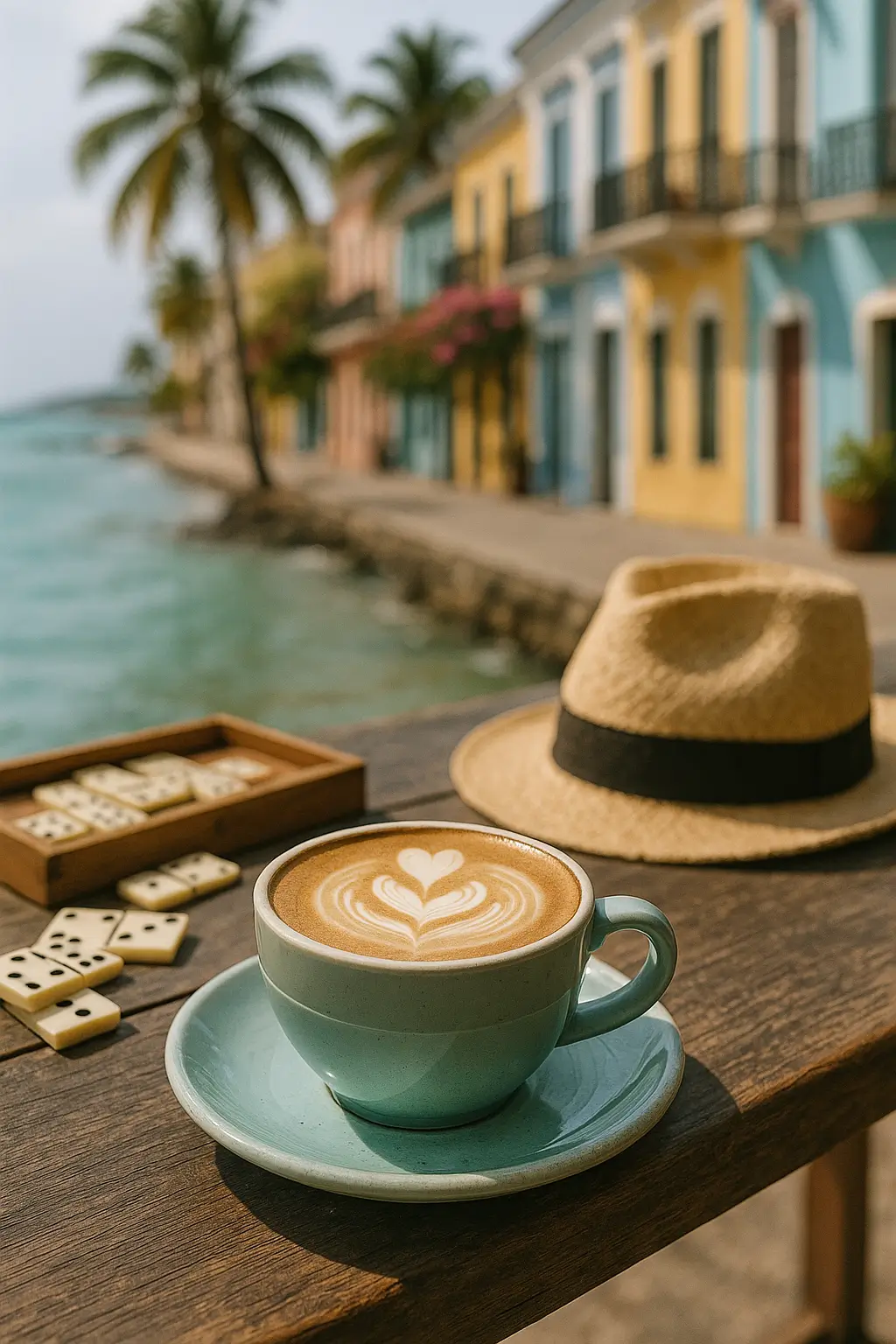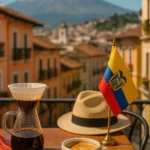Caribbean coffee truly stands out. It draws in coffee lovers everywhere. You’ll notice its silky smoothness, a real treat that defines it. This coffee offers a balanced, creamy flavor. It has low to moderate acidity. The region’s tropical highland climate and mountainous terrain create perfect growing conditions. These help give it an exquisite taste and a complex aroma.
- What does the Caribbean coffee taste like? Flavor profile and characteristics
- Major Caribbean coffee producers and their unique profiles
- The ideal terroir: Growing conditions that define Caribbean coffee
- A rich history: The legacy of coffee in the Caribbean
- Caribbean coffee versus other global regions
- What makes Caribbean coffee a unique experience?
What does the Caribbean coffee taste like? Flavor profile and characteristics
Caribbean coffee offers a pleasant experience. It has a medium to full body. This provides a satisfying feel with every sip. The region’s coffee features a balanced acidity and a distinct sweetness.
You often find complex flavor notes. Expect rich chocolate and various nuts. You might also discover bright fruit hints, like citrus or berries. Delicate spice notes can appear too. High-quality Arabica beans make this profile possible. Also, hand-picked selective harvesting ensures only ripe cherries are processed. This improves the coffee’s quality and creamy body. Caribbean coffee often has an inherent sweetness and a clean finish. The careful hand-picking process elevates the bean’s natural complexities.
Major Caribbean coffee producers and their unique profiles
The Caribbean has many coffee-producing nations. Each adds distinct profiles to Caribbean coffee. These islands use their unique land to grow exceptional Arabica beans. This often leads to specific flavors connoisseurs seek. Each producer offers something special:
- Jamaica – The legend of Blue Mountain Coffee: Jamaica Blue Mountain Coffee is famous and highly valued among Caribbean coffees. People worldwide praise its smooth, mild flavor and bright acidity. This coffee consistently offers a rich, creamy body. It coats your palate beautifully.You can find notes of chocolate, nuts, and fruit. These mix to create a complex, enjoyable experience. It holds its spot as one of the best Caribbean coffees due to its protected designation of origin. This ensures strict quality control within the Blue Mountain Area. The beans have a unique blue-green color. This visual sign tells you about their premium quality.
- Dominican Republic – The region’s largest producer: The Dominican Republic produces the most Caribbean coffee by volume. Its coffee is typically rich and full-bodied. It offers satisfying depth of flavor. Dominican coffee has balanced acidity and a pleasant, subtle sweetness.Common flavor profiles include chocolatey or fruity notes. Key coffee-growing areas are Barahona, Jarabacoa, Constanza, and El Cibao Valley. Each contributes to the coffee’s unique character. You can find popular brands like Cafe Santo Domingo, Induban Gourmet, Barahona Coffee, and Monte Alto. They show the excellence of Dominican coffee.
- Puerto Rico – A revival of quality: Puerto Rican coffee is getting new attention for its high quality. It has unique characteristics. People value its smooth taste. It offers delicate hints of caramel, giving a subtle sweetness. The coffee usually has a mild acidity. This helps its overall balance.The Yauco region is known for producing high-quality beans. The brand Yaucono is a local favorite. The island’s coffee industry continues to focus on quality. This fuels a strong comeback in its production and global standing.
- Haiti – Rich history, mellow flavors: Haitian coffee holds an important place in the region’s history. It once was a major global producer. Today, it ranks second in Caribbean coffee exports by volume. This shows its lasting importance. Haitian coffee usually uses the natural processed method. Cherries dry with the fruit still on them. This makes the coffee sweeter.This method results in rich, mellow, and sweet flavors. It has a characteristic low acidity. The coffee often offers a pleasant nutty profile. Haiti’s mountains provide excellent potential for its coffee industry, despite challenges. This promises a flavorful future.
- Costa Rica – A neighboring powerhouse: Costa Rica is in Central America. But people often talk about its coffee with premium Caribbean coffee. This is due to its closeness and similar focus on quality. Costa Rica only grows Arabica beans. This shows its commitment to high standards. Notable varieties include San Marcos di Tarrazu, Tres Rios, and La Minita. Each contributes to its good reputation.These coffees are known for their sweet, full-bodied flavors. They also have a lively acidity. This adds vibrancy to your cup. Costa Rican coffee shows the rich variety found in Latin American coffee.
The ideal terroir: Growing conditions that define Caribbean coffee
The Caribbean’s unique growing conditions shape its coffee’s quality and taste. The region’s tropical highland climate provides consistent warmth and humidity. This is ideal for coffee plants. The prominent mountainous terrain offers essential high altitudes. These are crucial for developing complex flavors.
Also, the rich, well-drained soil often comes from volcanoes. It nourishes the plants with vital minerals. These different altitudes and soil types slow the bean maturation process. This longer growth period creates denser beans. Denser beans then develop more complex flavors. These are typical of premium Caribbean coffee. These environmental factors contribute to a rich aroma, a heavy body, and delightful earthy notes. You’ll also find various fruity notes and natural sweetness. The mix of altitude, volcanic soil, and tropical climate creates a micro-environment unmatched for coffee. This leads to the exceptional density and flavor complexity in Caribbean beans.
A rich history: The legacy of coffee in the Caribbean
The history of Caribbean coffee cultivation connects deeply with the region’s colonial past. It also links to its social and economic growth. Coffee plants arrived in the Caribbean during the early 18th century. European powers, like Spain and France, brought coffee to islands such as Puerto Rico, Martinique, Haiti (then Saint Domingue), and Trinidad and Tobago.
Coffee farming relied heavily on enslaved African labor. This made coffee a major part of colonial trade. The brutal plantation conditions contributed to the Haitian Revolution in the 1790s. This was a key event, the only successful slave revolt in the Americas. After this revolution and other regional changes, coffee plants spread from the Caribbean to Central and South America. Coffee changed from just a colonial item to a cultural staple. It is now deep in the region’s identity and daily life.
Economic priorities have shifted over time. But coffee still plays an important economic role in many Caribbean nations. Small, quality-focused farms maintain this rich agricultural and cultural legacy.
Caribbean coffee versus other global regions
Caribbean coffee holds a special place in the world. Its unique qualities set it apart from coffees grown elsewhere. It typically offers a sweet, balanced, and clean flavor. You notice a creamy body. This unique balance and silky smoothness define Caribbean coffee.
Let’s compare it to other prominent coffee profiles:
- South American coffee profile: Coffees from South America, like Brazil and Colombia, are known for sweet, mild, and nutty qualities. Brazilian coffees often have notes of caramel, peanut, and cinnamon. Colombian coffees typically show a mild, sweet, nutty taste with medium acidity.
- African coffee profile: African coffees, especially from Kenya and Ethiopia, often have bright acidity. Their flavors are intense and distinct. They show vibrant fruity, floral, and spicy notes. These include grapefruit, strawberry, chocolate, and various berries. African varieties often have a more complex, lively acidity.
Dominican coffee shows Caribbean smoothness and balance. It also shares traits with cleaner Central American coffees. This is due to its traditional wet processing. The unique growing conditions in the Caribbean, including its tropical highland climate and volcanic soil, help give it its balanced, smooth character. This sets it apart from the bolder acidity of African coffees or the classic nutty sweetness of South American varieties.
Here is a quick look at key differences:
| Region | Flavor Profile | Acidity | Body | Key Characteristics |
|---|---|---|---|---|
| Caribbean | Sweet, balanced, clean, chocolate, nuts, fruit, spice | Low to moderate, balanced | Medium to full, creamy, silky smooth | Distinct sweetness, clean finish, hand-picked quality, tropical highland climate, volcanic soil |
| South America (e.g., Brazil, Colombia) | Sweet, mild, nutty, caramel, peanut, cinnamon | Medium | Medium | Often consistent, approachable, classic coffee flavor |
| Africa (e.g., Kenya, Ethiopia) | Fruity, floral, spicy, grapefruit, strawberry, chocolate, berries | Bright, complex, lively, pronounced | Light to medium | Vibrant, intense, unique, often sun-dried (natural processed) |
What makes Caribbean coffee a unique experience?
Caribbean coffee offers a unique experience. Its flavor profile, long history, and specific growing conditions make it special. Its consistent silky smoothness and perfectly balanced flavor provide a captivating taste journey. You’ll often notice a distinct sweetness. These elements combine to create a coffee that is both comforting and exciting.
Centuries of coffee cultivation history in the Caribbean enrich each cup. It tells stories of resilience and heritage. Discover the diverse varieties of Caribbean coffee. Let your palate find the unique tastes each island offers.









